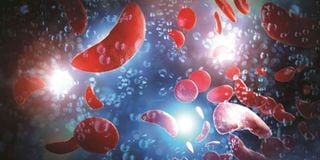New cure for sickle cell disease moves closer to reality

In Kenya, 14,000 children are born with sickle cell disease yearly.
What you need to know:
- Up until now, the only treatment for sickle cell disease has been stem cell or bone marrow transplant.
- In Kenya, the first bone marrow transplant procedure was carried out last October.
A new treatment under review by the US Food and Drug Administration’s independent advisory committee could cure sickle cell disease.
If approved, the new treatment called exa-cel, made by Boston-based Vertex Pharmaceuticals and the Swiss company CRISPR Therapeutics, will be the first FDA-approved treatment that uses genetic modification called CRISPR.
CRISPR is a technology that researchers use to selectively modify DNA, the carrier of genetic information that the body uses to function and develop.
Up until now, the only treatment for sickle cell disease has been stem cell or bone marrow transplant. In Kenya, the first bone marrow transplant procedure was carried out last October. Although experts said it opened up the treatment option for people living with sickle cell in the country, FDA states that stem cells transplants are risky and may not work and sometimes a transplant can kill a patient. The agency further indicates that fewer than 20 perc ent of patients have an appropriately matched donor.
The new exa-cel treatment under FDA’s consideration can use the patient’s own stem cells. Doctors would alter them with CRISPR to fix the genetic problems that cause sickle cell, and then the altered stem cells are given back to the patient in a one-time infusion.
Dr Stephanie Krogmeier, vice-president for global regulatory affairs with Vertex Pharmaceuticals Incorporated, told the panel that the treatment was considered safeand it had a “highly positive benefit risk for patients with severe sickle cell disease,”
Thirty-nine of the 40 people tested with the treatment did not have a single vaso-occlusive crisis, which means the misshaped red blood cells block normal circulation and can cause moderate to severe pain. It’s the number one reason patients with sickle cell go to the emergency room or are hospitalised. Before the treatment, patients experienced about four of these painful crises a year, resulting in about two weeks in the hospital.
Dr Daniel Bauer, principal investigator and staff physician at Dana-Faber/Boston Children’s Cancer and Blood Disorders Center, Boston Children’s Hospital, said the risk of the potential unwanted or adverse alterations to the genome that could accidentally happen in this process and cause cancer or other problems down the road is “relatively small.”
Africa accounts for more than 66 per cent of the 120 million people living with sickle cell disease in the world, with approximately 1,000 children born with the disease every day in Africa. According to research, more than half of these children will die before they reach the age of five, usually from infection or severe anaemia.
In Kenya, it is estimated that 14,000 children are born with Sickle Cell Disease every year but experts argue the figures might be higher because there is lack of an efficient system to capture the disease data when children are being born.
However, the FDA is not expected to make an approval decision until its deadline, which is December 8.




